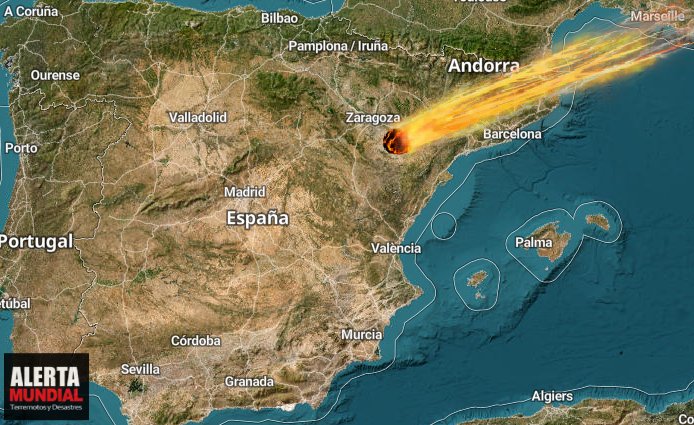Alaska
AMS event #7301-2023 caught from Wasilla US


Translated with DeeplA bright fireball streamed! This is a view of the fireball at 0:13:12 on December 3, 2023, as captured by a telephoto camera facing zenith from Fuji (at 0.5x speed).It intensified violently and turned completely white.The remaining meteor trail was swept away by the wind in the upper atmosphere and changed its shape.It was a fireball of scattered meteors.
Meteor captured from Providencia, Santiago de #Chile (December 05, 2023). #Meteor #Meteorite #Fireball #Climagram #Bolido
Bright fireball crosses the skies of #Alicante #Murcia and #Almeria in Spain
Tonight (dec 23), around 20:34 hrs from the webcam at La Mata lagoon.
#SUPERBOLID #meteor #fireball #bolide

A 'bolide' crosses the skies over Puglia: video of the meteor (over 10 seconds long) goes viral
FOGGIA - A bright 'bolide' streaked across the skies of Apulia at dawn on Wednesday, 27 December. The "ball" of light was immortalised by a camera and shared by the "Meteo Fasano" Facebook page: a meteor characterised by its intense brightness ploughed through the atmosphere, providing an astonishing spectacle that captured the attention of meteorology enthusiasts.
This is not the first encounter with a bolide for the Meteo Fasano community, which had already documented a similar event in early December.
However, this time the passage was described as even more spectacular, with an exceptional duration of more than 10 seconds.
Unlike ordinary meteors, the bolts, in addition to their classic white colour, can present a wide range of hues, including emerald green, red, electric blue and orange, making the visual experience even more fascinating. Their distinctive brightness and possible colour change make them extraordinary celestial objects.
According to experts, they can not only capture the human eye with their spectacular brightness but also emit sounds.
These noises are similar to distant thunder, artillery salvos or quarry mine explosions. In this particular case, the sighting of the bolide occurred at 6:04 a.m., a time when most people were still enveloped in sleep.
However, thanks to the alertness of enthusiasts and technology, the event was captured and shared, allowing everyone to appreciate the fleeting but extraordinary beauty of this celestial phenomenon.

The Quadrantids can be one of the strongest displays of the year, yet they are difficult to observe. The main factor is that the display of strong activity only has a duration of about 6 hours. The reason the peak is so short is due to the shower’s thin stream of particles and the fact that the Earth crosses the stream at a perpendicular angle. Therefore, the Earth passes through the densest portion of the stream quite quickly. Meteors from this source can be seen for two weeks centered on January 4th, but hourly rates away from the date of maximum activity are very low. Unlike most meteor showers, which originate from comets, the Quadrantids have been found to originate from an asteroid. Asteroid 2003 EH1 takes 5.52 years to orbit the sun. It is possible that 2003 EH1 is a “dead comet” or a new kind of object being discussed by astronomers, sometimes called a “rock comet.”
These meteors were first noted in 1825 and appeared to radiate from the obsolete constellation of Quadrans Muralis (Mural Quadrant).
Today, this area of the sky lies within the boundaries of the constellation of Boötes the herdsman. During early January nights as seen from the northern hemisphere, this area of the sky lies very low in the northwest in the evening sky. Very little activity is normally seen at this time. As the night progresses, this area of the sky swings some 40 degrees beneath the northern celestial pole. From areas south of 40 degrees north latitude, it actually passes below the horizon. It then begins a slow rise into the northeastern sky where it obtains a useful altitude around 02:00 local standard time (depending on your latitude). It is between this time and dawn that you will have your best chance to view these meteors. If the peak occurs during this time you will be in for a treat as rates could exceed 100 per hour as seen from rural locations under a moonless sky. Unfortunately a half-illuminated moon will rise shortly after midnight this year and moonlight will tend to obscure the faintest meteors. While moonlight will be a nuisance, it is not nearly as bad when a full moon is present. Successful observations can be undertaken by facing northward away from the moon. Using a tree or building to block the moonlight will also help you view more activity.
End snip:
The Quadrantids activity is one of the best of the year but lasts only one day.





On 08.01.2024 night three of our meteor cameras have captured quite a bright fireball. One of them has a diffraction grating, so we've got a fireball's spectrum. A set of lines typical for a chondritic meteorite is visible in the spectrum. All lines represent neutral atoms, lines of ionized elements are absent. This is associated with the low velocity of the meteoroid (Vg=12.4 km/s). The ratio of Mg-Fe-Na lines shows approximately equal intensities of these elements, but with some excess of iron. It is precisely due to the bright lines of iron (as well as magnesium) in the green region of the spectrum that this bolide has a bright green hue in the color image. The spectrum revealed lines of the following chemical elements: iron, magnesium, sodium, chromium, calcium, silicon, potassium, manganese, nickel, titanium, oxygen ,and nitrogen.

 alertamundialinfo.com
alertamundialinfo.com
